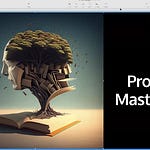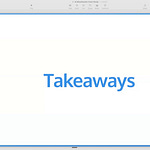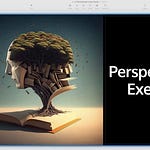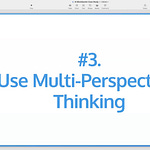Class Overview
In this action-oriented class, I guided participants through the complete process of creating and publishing their first prompt-based content piece. This hands-on approach moves beyond theory to actual execution—the key differentiator between those who succeed with AI and those who don't.
Rather than creating a prompt from scratch, I recommend finding an existing framework you already love and being the first to turn that into a prompt.
By building on proven frameworks that already have "borrowed credibility," you can dramatically increase the chances of creating content that resonates, rather than starting with completely original ideas that face the brutal "evolutionary landscape" where most new concepts "die a silent, quiet death of obscurity."
The class covered three key strategic foundations:
Why Substack Notes - The platform advantage of creator-aligned incentives vs. social media's commoditized content model
Skill Progression Methodology - Starting with curation and short posts before scaling to longer content (avoiding the common mistake of jumping to books without building habits)
The Random Impact Rule - Scientific research showing that even top performers can't predict their breakthrough work, making high-volume experimentation essential
For the final third of the class, I provided participants with three practical tools to create their first post:
Framework-to-Visual Prompt - Converting well-known frameworks (like Simon Sinek's "Start with Why") into engaging visual content using AI
Style Library Access - Curated design styles to create professional-looking illustrations instantly
Post Generation Template - A prompt system to transform any framework into a complete social media post
These three tools alone enable someone to go from idea to published post in under two hours. I'm not exaggerating—multiple participants created and shared their visual frameworks during the live class.
The session emphasized the "throw your hat over the wall" mentality: taking action despite not having perfect clarity on niche, audience, or quality levels, because consistent experimentation beats perfect planning in the rapidly evolving AI landscape.
AI-Generated Podcast Summary Of The Class
RECORDING RESOURCES
Classes In The 6-Figure Prompt Newsletter Track
Prompts Mentioned In Class
Presentation Slides
Class Transcript
Resources Shared
AI Timestamps
AI Chapter Summaries
Chat Transcript
Visit Other Classes In The 6-Figure Prompt Newsletter Track
Prompts Mentioned In Class
Presentation Slides
Class Transcript
Resources Shared
Visual Styles
Janis Ozolins on X
Jessica Hagy on X
Lizandmollie on X
Matt Shumer on X
VV (Visualize Value) on X
Spetchplantations on X
Amber Rae on Instagram
Dylan Jardon on Instagram
Vizi Andrei on Instagram
Michael Simmons on LinkedIn
Una Doyle on LinkedIn
Sam William on Substack
Janet Ridsdale on Substack
Kristin van Tilburg on Substack
Michael Glenn on Substack
Kevin Whitcher on Substack
Articles By Michael
Articles By Others
Tools
AI Timestamps
Introduction and Course Overview (00:00:03 - 00:09:05)
Why AI-First Learning and Class Objectives (00:09:05 - 00:22:00)
Platform Strategy: Why Substack (00:22:00 - 00:32:30)
Content Strategy: Curation vs Creation (00:32:30 - 00:41:00)
Framework-Based Approach for Prompts (00:41:00 - 00:46:30)
The Random Impact Rule Research (00:46:30 - 00:56:30)
Consolidated Gains Strategy (00:56:30 - 01:08:30)
Monetizing Your Prompt Library (01:08:30 - 01:15:30)
Creating Visual Prompts with AI (01:15:30 - 01:26:30)
Hands-On Creation Session (01:26:30 - 01:39:30)
Infinite Prompting Deep Dive (01:39:30 - 01:43:30)
Final Q&A and Action Steps (01:43:30 - 01:45:44)
AI Chapter Summaries
Introduction and Course Overview (00:00:03 - 00:09:05)
Michael opens by discussing the challenge of finding perfect tools for second brains and note-taking, mentioning his preference for Google Docs due to AI integration. He welcomes students to the second class of the 6-Figure Prompt Newsletter course, emphasizing this session's focus on taking action to build significant side income. He recaps the previous week's three classes covering infinite prompting and possibility prompting concepts, explaining how AI can be used beyond conventional search to discover unprecedented knowledge and map new territories.
Why AI-First Learning and Class Objectives (00:09:05 - 00:22:00)
Michael explains his 6-figure newsletter blueprint approach, demonstrating how teaching live classes, creating content, and marketing can be integrated rather than operating as separate activities. He discusses the compressed opportunity windows in AI and emphasizes the importance of taking action quickly. The main pedagogy focuses on supporting students through action-taking and feedback loops. He addresses the psychological aspects of publishing online, encouraging students to "throw their hat over the wall" and overcome internal resistance about not being ready or being an expert.
Platform Strategy: Why Substack (00:22:00 - 00:32:30)
Michael makes a compelling case for choosing Substack over traditional social media platforms. He distinguishes between social platforms (Instagram, TikTok, LinkedIn) that monetize user attention and creator platforms like Substack that only make money when creators make money. This alignment of incentives means creators are customers rather than commoditized content suppliers. Substack Notes provides a social component within the same ecosystem, eliminating the need to drive traffic between platforms. He notes Substack's rapid growth and current sweet spot of expansion without saturation, mentioning recent high-profile creator migrations to the platform.
Content Strategy: Curation vs Creation (00:32:30 - 00:41:00)
Michael advocates for starting with curation rather than original content creation, explaining the concept of "borrowed credibility." Using the subway test metaphor, he illustrates how people process information streams and naturally gravitate toward familiar names and concepts. He emphasizes that most ideas fail in the "evolutionary landscape of ideas," so building on proven frameworks dramatically increases success chances. The discussion includes a participant question about integrating frameworks into personal recovery stories, demonstrating how to blend curation with personal narrative.
Framework-Based Approach for Prompts (00:41:00 - 00:46:30)
The session focuses on why frameworks make excellent subjects for AI prompts. Michael explains that frameworks represent a manageable, collectible set of tools that people want to use better in their lives. He shows examples of successful posts combining well-known frameworks (like Simon Sinek's "Start with Why") with AI prompt applications. The strategy allows creators to leverage existing familiarity while adding the novel element of AI assistance. He also discusses the progression from short social posts to longer articles, emphasizing how shorter content enables more experimentation, feedback loops, and iterations.
The Random Impact Rule Research (00:46:30 - 00:56:30)
Michael presents fascinating research about scientific careers and the Random Impact Rule, showing a video that explains how impact in scientific publications is randomly distributed regardless of career stage. The research reveals that productivity (number of attempts) matters more than timing, and that scientists have a constant Q-factor (ability) throughout their careers. This research supports the strategy of creating many smaller pieces of content rather than focusing solely on perfecting fewer pieces. Mark Brown shares his advertising agency experience creating the "What happens in Vegas stays in Vegas" campaign, providing real-world validation of the repetition and persistence principles.
Consolidated Gains Strategy (00:56:30 - 01:08:30)
Michael introduces the "Consolidated Gains" model from venture capitalist thinking, using comedians as examples of how professionals test material in small venues before scaling to major performances. The strategy involves starting with many small posts, identifying what works, and then doubling down on successful content by expanding it into longer articles, detailed instructions, or comprehensive guides. This approach allows creators to benefit from both high-volume experimentation and the leveraged impact of proven content. The model helps creators avoid the split attention problem between social media posting and paid content creation.
Monetizing Your Prompt Library (01:08:30 - 01:15:30)
The discussion covers how to transform social posts into paid offerings by organizing prompts into categorized, synergized libraries. Michael explains how prompts work together in sequences (like root cause analysis → solution brainstorming → action selection) and how organizing them reduces overwhelm for users. He recommends starting with lower pricing ($10/month) and gradually increasing, taking advantage of Substack's grandfathering feature where existing subscribers keep their original pricing forever. This creates urgency for new subscribers and allows for sustainable growth. The strategy turns social content creation into direct paid newsletter content development.
Creating Visual Prompts with AI (01:15:30 - 01:26:30)
Michael demonstrates how to create compelling visual representations of frameworks using AI tools like ChatGPT's image generation. He shows examples of transforming frameworks into "glibby-style" illustrations, including his work with the "Made to Stick" framework and sketchplanations-inspired designs. The process involves uploading reference images and asking AI to create illustrations in specific styles. He provides a comprehensive list of different visual styles for inspiration and emphasizes the importance of crediting original artists and linking back to them. Students practice creating their own framework visualizations during this hands-on segment.
Hands-On Creation Session (01:26:30 - 01:39:30)
Students actively create their own visual prompts while Michael provides real-time feedback and encouragement. Participants share their creations including Joe Dispenza frameworks, wisdom of crowds concepts, and other popular frameworks rendered in AI-generated visual styles. Michael emphasizes the importance of posting content as Substack drafts to build a library for future paid newsletters, explaining how this approach solves the common problem of content migration and formatting issues later. He discusses the emotional aspects of posting online and encourages students to work through resistance and uncertainty.
Infinite Prompting Deep Dive (01:39:30 - 01:43:30)
Kristin asks detailed questions about the infinite prompting technique, specifically about how to slow down AI thinking and access extended reasoning. Michael explains that speed isn't the key metric since AI will become exponentially faster over time. He shares techniques for encouraging deeper thinking, including extended thinking modes and Matt Schumer's ultra-deep thinking prompts. The discussion covers how to access Claude's artifact history to see the AI's thinking process and research steps, providing transparency into the reasoning behind outputs.
Final Q&A and Action Steps (01:43:30 - 01:45:44)
The session concludes with discussions about AI ethics, treating AI as collaborative partners rather than tools to be threatened or manipulated. Zain shares his successful Reddit post about getting personalized AI recommendations based on chat history, demonstrating authentic content creation. Michael emphasizes the importance of having both experimentation platforms (for testing ideas) and blockbuster platforms (for best work), encouraging students to start posting and building community connections. He reminds everyone to "throw their hat over the wall" and begin taking action immediately, setting up the framework for ongoing support and community building.
Chat Transcript
00:07:08 Michael Glenn: yes
00:07:11 Aakash: yes
00:07:12 Josh- Tracer Franchising: hi Michael, before we get going quick question- do you still use Notion or have you switched to Notebook LLM or some other AI?
00:08:18 Michael Glenn: Josh - I asked GPT which would work best for me and it recommended Notion as the best choice for my needs. I'd say put this same question to AI yourself and see what it tells you
00:09:01 David Stepania: obsidian is good
00:09:29 Michael Simmons: https://blockbuster.thoughtleader.school/p/infinite-prompting-get-ai-to-think
00:09:42 Michael Simmons: https://blockbuster.thoughtleader.school/p/the-prompt-leadership-revolution
00:09:53 Phil Powis | Sacred Business Flow: Ive tested prompts the past week in my substack emails, and definitely driving paid subscribers 💪…early days but exciting to see how this will keep unfolding
00:10:07 Dani Trusca: Replying to "obsidian is good"
obsidian is good
I adore Obsidian.
00:10:29 Mark Brown: Good morning from Kennedy airport! Sorry no video this morning. Heading home to Las Vegas. Great article Michael.
00:10:52 Janet Ridsdale: Morning all, apologies audio only
00:11:43 Michael Simmons: https://blockbuster.thoughtleader.school/archive
00:12:34 Marcin Podolski: Hi everyone
00:12:37 Stanley Wilson: Can’t show video for the first half hour. ty
00:12:54 Ram Iyer (www.MiTRamiyer.com): where do I find the transcripts?
00:13:05 Michael Simmons: https://blockbuster.thoughtleader.school/archive
00:13:53 Jonathan Hughes: Would you suggest that we go through Frontier Prompting course as well as Infinite Prompting?
00:14:50 John Kelly: Congrats - you've pout in a ton of work
00:15:20 Jonathan Hughes: Infinite Prompting course: https://blockbuster.thoughtleader.school/t/infinite-prompting-5-lesson-course
00:17:25 Ram Iyer (www.MiTRamiyer.com): At this link, where do I find the transcript: https://blockbuster.thoughtleader.school/archive ??
00:17:29 Bonnie J.: I love that!
00:17:47 Kevin Whitcher: Are you supposed to be screensharing Michael? If so, not seeing it
00:17:58 John Kelly: yes
00:18:03 Mark Brown: yes
00:18:54 Marcin Podolski: 🚀 Quick brain-spark on ‘ego stage’ ladders vs. Nora Bateson’s living ecosystems:
“Every staircase looks logical—until you realise you’re inside the house it claims to measure.”
Bateson calls Wilber/Kegan/Cook-Greuter a gorgeous piece of colonial furniture: elegant, linear, and secretly designed to rank who gets the penthouse. Her alternative? Symmathesy—a forest of co-learning where relationships evolve, not isolated egos.
🌱 3 mini aha’s to chew on:
Warm Data > Cold Metrics Growth isn’t a frozen snapshot; it’s the humidity between snapshots.
Observer entangled If you’re mapping a hierarchy, congrats—you just added yourself into the hierarchy.
Aphanipoiesis Real transformation often slips in sideways, like night-blooming jasmine—gone by morning test time.
So next time a model promises to scale you “beyond integral,” ask: Is this a telescope—or a mirror held by the system to itself?
Let’s trade ladders for lanterns and explore the terrain together. 💡
00:20:35 Kevin Whitcher: Great - need to get something up!
00:20:36 Samuel Rodgerson: Excitement!
00:20:37 Phil Powis | Sacred Business Flow: Lets gooooo!! Is what happens for me :)
00:20:41 Jonathan Hughes: maybe we can wait til tomorrow?
00:20:46 Malliha: Exposed, vulnerable, and activated
00:20:49 Michael Glenn: I do it all the time
00:20:52 John Kelly: Worry about level of quality I can produce
00:21:00 Stephen Hendricks: Adrenaline
00:21:03 Bonnie J.: Fear, because I don’t have any social media accounts right now and I haven’t chosen a topic
00:21:29 Jonathan Hughes: Replying to "Fear, because I don’..."
Yes! I'm also starting from scratch
00:21:33 Phil Powis | Sacred Business Flow: One topics that has been coming up with my partner and I is ethical responsibility when we are using prompts for deeper inner work
00:21:51 Vikram K: Replying to "Fear, because I don..."
Same here!
00:22:29 Malliha: Replying to "One topics that has ..."
Powerful focus
00:22:41 Jonathan Hughes: Replying to "One topics that has ..."
and the possibility of liability...what if a shared prompt leads someone off kilter?
00:22:53 Janet Ridsdale: Learning. I am encouraging my audience to embrace both human connection and language of AI
00:23:49 Michael Glenn: Replying to "Learning. I am enc..."
It's a game changer for me to realize that, as the writer, I am the "community leader" for the people I'm writing to.
00:24:27 Michael Glenn: OMG that's me for the last 20 years hahaha
00:25:03 John Kelly: LOVE that - expodential results
00:25:36 John Kelly: Can I get the url to that video?
00:25:55 Malliha: absolutely
00:25:56 Janet Ridsdale: yup
00:28:39 Marcin Podolski: "Doing small things you must think about big one in order to align with all the things to go in the right direction" - Alvin Tofler
00:30:04 Michael Glenn: I love the vibe on Substack. Notes are so much more fun than any other social media platform. It's a whole different experience
00:30:55 Malliha: I see notes as little nuggets of thoughts or sound bites (they’re easily digestible)
00:31:26 Josh- Tracer Franchising: how do I know my niche is there?
00:31:30 Michael Glenn: Replying to "I see notes as lit..."
I like that
00:31:42 John Kelly: Any 'science' to choosing a substack name for channel?
00:31:46 Janet Ridsdale: Substack Notes is a great driver of subscribers
00:31:52 Jonathan Hughes: Should Notes be the same length as an average Twitter (X) post?
00:32:15 Mark Brown: Yes good question on length
00:33:00 Dani Trusca: Replying to "Should Notes be the ..."
Substack Notes don't have a character limit.
00:33:24 Dani Trusca: Replying to "Should Notes be the ..."
Moreover, you can format them, unlike tweets, and edit them at any time.
00:33:33 Malliha: Replying to "Should Notes be the ..."
I plan on experimenting with lengths to see which gains the most traction. It also depends on your audience.
00:35:02 Marcin Podolski: My Prompt Created Now: **“Act as a trans-disciplinary think tank tasked with inventing three novel vertical-development patterns that escape conventional ‘stage’ theory.<br>
Embed every pattern in overlapping ecological, social, and emotional contexts (Warm Data).<br>
Write from an observer-entangled stance—acknowledge how the theorist’s viewpoint shapes what ‘development’ even means.<br>
Introduce an aphanipoietic trigger: a subtle, sideways event that quietly vaults individuals/collectives into the new pattern.<br><br>
Deliver:<br> • A punchy codename & 20-word descriptor for each pattern.<br> • A relational map (≤120 words) showing its webs of influence.<br> • One counter-intuitive practice that accelerates the shift.<br> • A single metric most consultants would miss—and why ignoring it stalls growth.”**
00:36:44 Malliha: Replying to "My Prompt Created No..."
Thanks for sharing. Did you receive an output you are content with or … Did you learn anything from the output?
00:36:59 John Kelly: y
00:37:03 Dani Trusca: Replying to "Should Notes be the ..."
They do have a visibility limit, in that after a number of characters or lines, the reader needs to press More to reveal the rest.
00:37:05 Janet Ridsdale: yes
00:38:12 Malliha: yes
00:38:13 Stanley Wilson: yes
00:38:14 Janet Ridsdale: yes
00:38:14 Marcin Podolski: yes
00:38:24 Janet Ridsdale: yes
00:38:24 Marcin Podolski: yes
00:38:25 Stanley Wilson: y
00:38:26 Stephen Hendricks: Yes
00:38:44 Una Doyle: Business Coach (Double Your Profits): Yes
00:39:10 Marcin Podolski: not published yet
00:41:24 Jonathan Hughes: Note to self: find the difference between framework and paradigm
00:41:30 Mark Brown: Can you give a few examples of recent frameworks?
00:41:52 Max Bernstein: Here is an example of a framework to put your own unique spin on other people’s content:
https://docs.google.com/document/d/1fjq4s8rIZ1p1JetLb4dS93049RKhduit7a1D2tZF4hI/edit?usp=sharing
00:41:52 Marcin Podolski: creativity equals imitations with our own unique hunches
00:44:01 Kevin Whitcher: How Simon Sinek helped me recover my mental health
00:44:16 Max Bernstein: @Michael Glenn one way is to find a unique angle within that framework and go deeper on that and why
00:44:25 Dani Trusca: Ask AI to recommend names.
00:45:26 Kevin Whitcher: Once it’s out there, all knowledge is universal
00:45:59 Bonnie J.: Or, “in retrospect, I realize now that what I was going through can be explained by X framework”… so you don’t have to have known the framework at the time the story happened.
00:46:14 Dani Trusca: Replying to "Once it’s out there,..."
"Everything in our lives comes from others." (John Cremer)
I see everything as a collective process.
00:46:24 Jonathan Hughes: Replying to "Or, “in retrospect, ..."
well put
00:47:27 Dani Trusca: I actually see short-form writing as an art form in itself. Compressed wisdom.
00:48:01 Michael Glenn: Maybe I can do the weekly post where I share my story, and then a few times a week I can share just one framework or prompt or whatever, and maybe those bonus posts can be for paid subs only?
00:48:16 Malliha: Replying to "I actually see short..."
I find short-form to be more challenging which is why I prefer it. To say more while write less is key.
00:48:46 Una Doyle: Business Coach (Double Your Profits): I used last Wed’s prompt and am in the reviewing stage - creating 5 more prompts. Even with the paid version of Claude it does keep stopping and I have to wait. I was thinking of pulling out different aspects and making it into a video series… (Wanting to do YT as well as substack) I used an old transcript just for the purpose of the exercise but it came up with some good stuff! :-)
00:48:54 Janet Ridsdale: Daily Notes?
00:49:36 Una Doyle: Business Coach (Double Your Profits): I did feel a bit - erm now what? LOL
00:49:42 Mark Brown: Daily on social media and weekly on Substack? Or all on Substack?
00:50:50 David Ford: Replying to "Or, “in retrospect, ..."
Good point, @Bonnie J.
I do this when reviewing prior professional experience as I update my resume. The Now Me understands and contextualizes old experience in ways that I couldn't when I was living the experience...
00:51:23 Michael Glenn: Replying to "I actually see sho..."
Short form writing is hard for me... I like to talk too much lol
00:52:46 Dani Trusca: I love the visualizations in the video.
00:55:21 Michael Glenn: So some people have a natural ability to create a bigger impact? That's my takeaway
00:55:45 John Kelly: There is hope for us old folk
00:55:47 Mark Brown: We all have a shot!
00:55:48 Kevin Whitcher: Keep firing flak!
00:55:52 Bonnie J.: The importance of keeping productivity high
00:55:54 Janet Ridsdale: numbers
00:55:57 Rhonda: P seems more like probability than luck.
00:55:59 Kristin van Tilburg: How little we can control our contributions
00:56:07 Marcin Podolski: Missing Infinite devotion
00:56:54 Michael Simmons: https://arxiv.org/pdf/1909.07956
00:57:08 Marcin Podolski: best to have Infinite devotion to exploration and in saturable curiosity
00:58:04 Michael Simmons: https://www.linkedin.com/in/michaeldsimmons/recent-activity/all/
00:59:02 Mark Brown: As former owner of a large ad agency, I learned over and over that constantly flooding the zone makes all the difference. As you said most messages get lost in the noise. We have to be out there constantly in order to be heard. In many ways it is so much easier today because of all of the various platforms
01:01:15 Malliha: But also ensuring the repetition = quality/value
01:02:49 Kristin van Tilburg: I heard yesterday that google estimates 40 touches before a purchase decision.
01:02:53 faythebuchanan: Sorry have to go. Great material!
01:02:54 Ram Iyer (www.MiTRamiyer.com): That is an approach that Trump uses
01:03:01 Marcin Podolski: repetition hacks basal ganglia which makes us familiar to them unconsciously and that's why automatically more trustworthy and credible, it is like a subconscious hacking.
01:03:50 Josh- Tracer Franchising: Got to go, thanks Michael
01:04:46 Bonnie J.: That’s wild
01:05:00 Malliha: I have to run, thanks Michael.
01:05:16 Marcin Podolski: Replying to "I have to run, thank..."
Bye. See You
01:06:23 Dani Trusca: It's a serendipity pattern. The best predictor may be the number of followers one has. The more followers, the more likely for someone to see it. (Positive Feedback Loop)
Consistent Quality Output => More Followers => More Visibility
01:06:33 Janet Ridsdale: Thanks Mark
01:08:21 Max Bernstein: Good use for Infinite Prompting
01:08:35 Max Bernstein: “Write an article, each artifact should also serve as a supporting social post"
01:09:49 Phil Powis | Sacred Business Flow: Ive been adding the paywall around the prompt the past week…is that what you mean? Woudl you do that vs removing it entirely? If you are using substack for paid
01:09:51 Zain Haseeb: Completely agree with flooding the zone, but the other thing to keep in mind is to also be authentic, sometimes in trying to flood the zone, we tend to start sounding like everyone else who is also posting because seeing their content is influencing our perception of what might go viral (if that makes any sense).
01:10:41 Jeff: structure is value and is a form of curation
01:10:52 Mark Brown: Replying to "Completely agree wit..."
Yes Authenticity is key
01:11:19 Mark Brown: Will you discuss what we charge for newsletter?
01:13:59 Zain Haseeb: Do you suggest turning on the pledge feature when we start our Substack?
01:14:37 Michael Glenn: I turned on paid subs right away. Two people out of 160 are paying subscribers
01:14:59 Marcin Podolski: Aversion Loss Bias and scarcicy effect are powerful marketing tools
01:15:06 Michael Simmons: https://docs.google.com/document/d/1vkyA7UoSVoKbejlNvvFhYdwx3QAtTVgUq4ureQdGN64/edit?tab=t.zalbjkaweu8p
01:15:15 Dani Trusca: I have a theory that social media is built on the implicit assumption that information only has value in the present. It's like everything you post disappears into a black hole. The clues are in the interface. eg How easily it is to access past information. If you need to scroll and scroll, it's not built for timeless insight.
There's a positive to this: any prompts you post, disappear into the black hole. So there may not even be a need to delete the prompts you post.
01:15:53 Zain Haseeb: Replying to "I turned on paid sub..."
That's awesome! Curious how many posts you launched the substack with? I think my struggle right now is I feel like I can't expect anyone to subscribe till I have some foundational content out there
01:16:12 Michael Simmons: Create a photo with a whiteboard of the made two stick framework (SUCCES) and the two authors of the book, Chip and Dan Heath in front of the white board looking at the camera. Create it in the style of ghibli. Incorporate a photo of their book into the image somehow.
01:16:34 Dani Trusca: I love the idea of turning books into prompts.
01:17:45 Michael Simmons: Create a photo with a whiteboard of the made two stick framework (SUCCES) and the two authors of the book, Chip and Dan Heath in front of the white board looking at the camera. Create it in the style of ghibli. Incorporate a photo of their book into the image somehow.
01:18:21 Michael Simmons: Create an illustration of Mel Robbins' 5-second rule in the style of the attached sketchplanations image.
01:18:24 Zain Haseeb: Replying to "I love the idea of t..."
Yes same, for my niche I have been trying to break down job descriptions into prompts
01:19:52 Una Doyle: Business Coach (Double Your Profits): Can you go back to the slide with the different examples please?
01:20:08 Michael Simmons: https://www.instagram.com/smart.nonsense/
01:20:12 Michael Glenn: This is what I prompted, I'm waiting for the image to render
Create a photo with a whiteboard with a framework on it that’s relevant to veteran’s mental health.
In front of the whiteboard, show the creators(s) of the framework.
If the creator(s) wrote a book where they talk about the framework, then incorporate of a photo of the book into the image somehow. If there is no accompanying book, then don’t show a book.
Create it in the style of ghibli.
01:20:21 Michael Simmons: https://x.com/visualizevalue
01:20:38 Michael Simmons: https://twitter.com/lizandmollie
01:20:46 Michael Simmons: https://www.instagram.com/viziandrei/
01:20:55 Michael Simmons: https://twitter.com/OzolinsJanis
01:21:02 Michael Simmons: https://www.instagram.com/heyamberrae/
01:21:20 Dani Trusca: An approach I'm experimenting with: posting companion prompts for the things I'm already writing.
eg
The same idea can be expressed in many ways.
I call them idea-forms:
a story, a metaphor, a diagram, a question, a mantra.
The best idea-forms don’t just inform—they transform.
They make you see. They make you feel.
In other words, they are poetic.
—
ChatGPT Prompt: What’s the best idea-form for this insight?
01:21:41 Michael Simmons: https://www.instagram.com/heyamberrae/
01:21:52 Michael Simmons: https://x.com/sketchplanator
01:21:54 Michael Glenn: It's pretty cool! Could be tweaked probably but it's more than I could come up with by myself
01:22:13 Michael Simmons: https://x.com/jessicahagy
01:22:13 John Kelly: I'm not understanding 'Framework' element of prompt
01:22:22 Dani Trusca: Replying to "An approach I'm expe..."
Lateral Insight: Think of prompts as another kind of idea-form.
01:23:59 Janet Ridsdale: ChatGPT tells me I am violating rumes. Not sure why
01:24:20 Una Doyle: Business Coach (Double Your Profits): Mine missed a bit - waiting for version 2
01:24:42 Mark Brown: Replying to "ChatGPT tells me I a..."
Me too
01:24:56 Michael Glenn: I just did this to get more framework ideas for myself:
Give me 10 frameworks that have been made famous by people who are living today. Name the person who created the framework. Choose frameworks that are directly applicable to mental health and self-reflection.
01:24:59 Michael Simmons: https://docs.google.com/document/d/1vkyA7UoSVoKbejlNvvFhYdwx3QAtTVgUq4ureQdGN64/edit?tab=t.zalbjkaweu8p
01:26:36 Michael Glenn: This opens up so many possibilities
01:26:54 Michael Glenn: I don't know where to start I just know this is gonna be big
01:26:57 Bonnie J.: Yes, much more excited. :) Also wanting to find a unique visual style that I could use consistently.
01:26:59 Kevin Whitcher: We are doing the next prompt now! Forget feedback
01:27:08 Bonnie J.: Unless that’s a bad idea and variety in visual style is better?
01:29:12 Marcin Podolski: SOCIAL MEDIA POST:
🚨 Most people ignore this hidden superpower… but it might be the key to your next breakthrough.
Imagine using the collective intelligence of everyone you've ever interacted with—even subtly—to unlock what you alone couldn’t see.
💡 Enter: The Wisdom of Crowds—but reimagined through AI. Instead of asking a group, what if you asked ChatGPT to become your personalized "crowd"?
🧠 Try this viral AI prompt that’s blowing people’s minds:
👉 “From everything you know about me, what 5 unconventional life or career decisions would a diverse group of my wisest friends and mentors agree I should seriously consider—but I’ve probably overlooked?”
✨ Prepare for:
A strange sense of déjà vu
Unexpected validation
Insight that feels eerily right
📢 Test it out and comment with the craziest or most spot-on idea it gave you. Let’s see what your ‘crowd’ knows that you don’t!
01:29:16 Marcin Podolski: WHY THIS WORKS:
This leverages the Wisdom of Crowds effect by turning ChatGPT into a simulated collective intelligence. The hook triggers curiosity by challenging what we think about insight and decision-making. It creates emotional resonance by implying there are answers just beyond your awareness, and it makes the user the center of a thought experiment—instantly engaging, immediately applicable, and irresistibly shareable.
01:29:23 Michael Glenn: This is going to change so many people's jobs lol... creatives around the world must start rethinking their lives immediately 😂
01:30:24 Una Doyle: Business Coach (Double Your Profits): Is the idea to use the framework prompt in Claude or ChatGPT or does it not matter?
01:31:10 Una Doyle: Business Coach (Double Your Profits): Replying to "This is going to cha..."
This is a huge issue for them, yes…
01:31:42 David Ford: Replying to "I love the idea of t..."
Whoa @Zain Haseeb, that got my attention! Can you say more about that? (either on here of offline)
davidaford8@gmail.com or www.linkedin.com/in/davidaford8
01:31:53 Michael Simmons: https://x.com/mattshumer_
01:32:13 Kevin Whitcher: SOCIAL MEDIA POST:
🚨 What if the version of "you" that you're trying to upgrade… is actually the problem?
Most self-help tells you to change your habits. But what if your thoughts, emotions, behaviours — and even your identity — are locked in a loop you don’t even notice?
That’s the idea behind Joe Dispenza’s “Breaking the Habit of Being Yourself” framework. It shows how most of us keep recreating the same life by thinking the same thoughts, feeling the same feelings, and making the same choices — without realising it.
🧠 Want to find out how you're doing this in your own life?
TRY THIS AI PROMPT:
“Based on everything you know about me, what patterns of thought, emotion, and behaviour do I keep repeating that are unconsciously keeping me stuck in my current reality — and what identity would I need to let go of to finally break that cycle?”
01:32:17 Kevin Whitcher: ⛓️ Be prepared. The response will feel uncomfortably accurate.
✨ It’ll reveal the exact identity loop that’s holding you back — and how to break it.
👇 Share your results in the comments or with a friend — you’ll be amazed what shows up.
WHY THIS WORKS:
Curiosity Hook: Challenges identity and common self-help advice — instant pattern interrupt
Emotional Resonance: Everyone feels “stuck” at some point — this offers a new way out
Immediate Payoff: The prompt promises deep insight with minimal input
Surprise Twist: Turns a business/self-development framework into a personal revelation
Virality Factor: It’s easy to copy, try, and share — invites communal exploration of identity loops
01:32:45 Una Doyle: Business Coach (Double Your Profits): Easier to read - but his pencil is in the day. Doesn’t matter I guess!
01:32:49 Kevin Whitcher: Marcin did one earlier
01:33:26 Michael Glenn: For those who said GPT told them it violates their policy, ask it this:
How does it violate the policy and what can we do instead?
01:33:32 Chris: Version two:
01:34:15 Jonathan Hughes: You were going to suggest where to store prompts in Substack?
01:34:46 Kevin Whitcher: Replying to "You were going to su..."
Maybe a post draft that you keep updating and never make public
01:36:35 Una Doyle: Business Coach (Double Your Profits): Is a post the same as a note/
01:37:05 Kevin Whitcher: Replying to "Is a post the same a..."
No! Notes are like a shop window to your Substack posts
01:37:26 Kristin van Tilburg: Micheal do you have a note that contains a prompt we can see?
01:37:53 Michael Simmons: https://blockbuster.thoughtleader.school/p/tell-me-where-ill-die-ai-prompt-use
01:38:30 Michael Simmons: https://substack.com/@michaeldsimmons/note/c-114920218
01:38:41 Kristin van Tilburg: My Thursday Post contains a prompt! So excited! Want to do notes before…should I use the prompt in my Thursday Newsletter?
01:40:38 Kristin van Tilburg: Is it ok to ask a question about infinite prompts?
01:40:40 Michael Glenn: My favorite question to ask GPT at the moment is:
"What else can we do with this?"
01:40:50 Kevin Whitcher: Just post! What’s the worst that can happen!
01:41:29 Gabriel: Michael, I am planning to go through all of your AI courses, and I’m in the second course so far. For some classes there are no transcripts. What’s the best way to get a transcript from the video in that case?
01:42:42 Zain Haseeb: Replying to "Michael, I am planni..."
Would like to get those too, I am going to be going through them too.
01:43:53 Mark Brown: Replying to "Michael, I am planni..."
Are you going to share these prompts with the outside world or will they be specific to this class for awhile?
01:44:49 John Kelly: Talk nasty - Google's Sergey Brin says AI works better when threatened: ‘We don’t talk about it…’ https://www.livemint.com/technology/tech-news/googles-sergey-brin-says-ai-works-better-when-threatened-we-don-t-talk-about-it-11748226345158.html
01:46:48 Michael Glenn: I want to work with GPT now to discover my own, preferred style for these images, so that they'll "fit" with the feel of my Substack... any thoughts on how to do that?
01:47:17 Zain Haseeb: Sharing a prompt I put out on Reddit on a whim a month ago that got some good response, actually what led me to start this content creation journey: https://www.reddit.com/r/ChatGPTPro/s/xo16QoRtkh
01:47:38 Zain Haseeb: Here’s the prompt Based on everything you know about me from our full chat history and memory, give me 10 high-leverage ways I should be using AI that I haven’t yet considered. Prioritize ideas that are tailored to my habits, goals, and work/life patterns even if they’re unconventional or unexpected.
01:48:04 Bonnie J.: You can also get better results sometimes by explaining stakes (i.e., why it’s so important for the task to get done, what it means to you if the AI helps you, etc).
01:49:35 Una Doyle: Business Coach (Double Your Profits): Replying to "You can also get bet..."
Interesting - yeah I’ve sometimes said, I need this for 1st thing in the morning for a meeting! 😂
01:49:35 Gabriel: Sorry I have a 5-year-old, homeschooled kid who just bumped his head really badly and I had to help him. I’m back but I couldn’t hear if Michael answered my question
Michael, I am planning to go through all of your AI courses, and I’m in the second course so far. For some classes there are no transcripts. What’s the best way to get a transcript from the video in that case?
01:50:22 Jeff: the usual caveat about new tech in large corporations if you don't have a good process AI will speed the issues within the process
01:50:46 Mark Brown: Replying to "Here’s the prompt Ba..."
this is really good. thank you for sharing
01:51:42 Una Doyle: Business Coach (Double Your Profits): http://linkedin.com/in/unadoyle - need to set up my Substack properly
01:51:44 Samuel Rodgerson: https://substack.com/@insightsamuel
01:52:01 Janet Ridsdale: https://jrnowwhat.substack.com
01:52:18 Kristin van Tilburg: kristinvantilburg.substack.com
01:52:18 Michael Glenn: https://substack.com/@themichaelglenn
01:52:33 Kevin Whitcher: https://substack.com/@thequantummiracle
01:52:43 Janet Ridsdale: Thanks Michael. Greatclass
01:52:47 Mark Brown: Really good class! Thank you!
01:53:04 Stephen Hendricks: Thanks
01:53:09 Marcin Podolski: bye everyone










